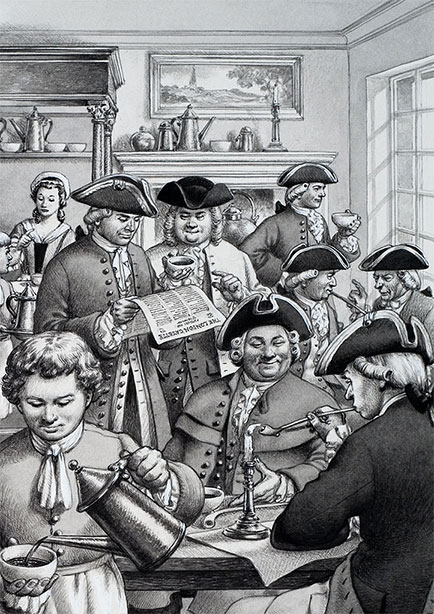The adventures of coffee in its way to conquer Europe

No one can imagine his everyday life without coffee, but before he conquered the Europeans' palates, coffee spread a remarkable journey that was connected with the history of the Old Continent.
Coffee can be an integral part of the everyday life of all Europeans, with Italy being the birthplace and global metropolis of espresso, but the spread of coffee in Europe was a slow and adventurous process that went through wars , sieges, slavery, but also merchant routes. Following the path of coffee to the cups of Europeans, we follow an important part of European history.
 Although the coffee plant is endemic of Ethiopia, coffee as a drink was born on the opposite shore of the Red Sea, on the Arabian Peninsula, and more specifically in the area of present-day Yemen. Slowly, coffee will be spread throughout the Arab - and more generally Muslim - world, while the expansion of the Ottoman Empire will help spread coffee from Syria and Egypt to Constantinople and the Balkans. Until the 15th century, however, coffee remains an Arabic affair.
Although the coffee plant is endemic of Ethiopia, coffee as a drink was born on the opposite shore of the Red Sea, on the Arabian Peninsula, and more specifically in the area of present-day Yemen. Slowly, coffee will be spread throughout the Arab - and more generally Muslim - world, while the expansion of the Ottoman Empire will help spread coffee from Syria and Egypt to Constantinople and the Balkans. Until the 15th century, however, coffee remains an Arabic affair.
No matter how strange, the first European country to taste coffee is Malta. The seat of the Knights of St. John, the small island state comes into contact with the new drink when the Ottoman prisoners of the Ioannites make coffee with the beans they own. Soon the new drink becomes the favorite of the high society of Malta, while at the same time European travelers refer to their books as coffee, such as Leonhard Rauwolf, from Germany, who tastes him in Aleppo of Syria in 1573.
However, coffee in Europe also found channels more peaceful than wars and slave-busts in order to conquer the cups of Europeans. The close trade links that have developed between Venice and the Arab world will trigger the introduction of coffee on European soil. Venetian traders, along with other East goods, import coffee and sell it to the Venetian aristocracy at high prices, paving the way for its proliferation in mainland Europe. The first coffeehouse on European ground, excluding the European lands of the Ottoman Empire and Malta, will open in Venice in 1645. The Italians embrace the new drink, but the Catholic Church has objections to the "Satan's drink" name it. Fortunately, Pope Clementy the 8th tastes the coffee, is enchanted by his taste and decides not to give him to the Devil, baptizing him with any "Christian drink" in a relative ceremony.
The adventurous journey of coffee naturally does not stop at the merchant ruler of the Venetians. In 1683, the Ottoman forces besieged Vienna, but were defeated and fleeing. Among the spoils left by the panicking retreating Ottomans, there are several sacks of roasted coffee beans, which are given to a Polish general as a reward for his services in defending the city. It was these sacks that functioned as "yeast" for the first coffeehouse in Austria, where coffee was for the first time served with sugar and milg, as the coffee was bitter for the demanding Viennese.
Slowly, coffee will spread to other European countries at a rapid pace. Although the first café in London opened in 1654, over 50 years, the city acquired more than 3,000 luxury and popular cafes, and so did countries like France and Germany, and its spread in the Netherlands was also the a reason for the spread of coffee growing for the first time outside Ethiopia and Arabia, after the Dutch managed to carry coffee seeds for the first time in their colonies in Indonesia, laying the foundation for the spread of coffee in Asia and, through it, America.
The history of coffee naturally does not stop there. Until we reach today's reality, coffee has gone through many, many stages - but that's a different story!










